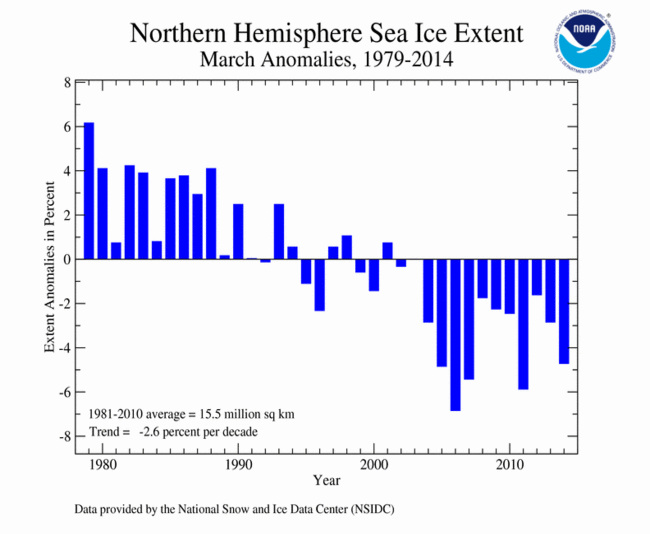Monthly Report Summary Information
The Monthly Report Summary Information is a synopsis of the collection of national and global summaries released each month.
Global Summary Information - March 2014
See Full Report
March 2014 global temperature fourth highest on record
Year-to-date seventh warmest on record
Arctic sea ice fifth lowest maximum extent
Many areas of the world experienced much-warmer-than-average monthly temperatures, including most of Europe, much of Asia, northern South America, most of the Indian Ocean, part of the eastern North Atlantic, a large swath of the South Atlantic, and large sections of the western and northeastern Pacific Ocean. Record warmth occurred in parts of eastern and northern Europe, sections of the eastern Atlantic Ocean, and parts of the equatorial and northeastern Pacific Ocean. Most of eastern Canada, the northeastern U.S., north central Argentina, part of the central North Atlantic Ocean, and the ocean waters off the southern tip of South America were notably cooler than average. Some areas around the Great Lakes and New England in North America were record cold for March.
Global temperature highlights: March
- Following a relatively cool February compared to the 21st century, the combined average temperature over global land and ocean surfacesfor March rebounded and was the fourth highest on record, at 56.18°F (13.41°C) or 1.28°F (0.71°C) above the 20th century average. The margin of error associated with this temperature is ±0.16°F (0.09°C).
- March marked the 38th consecutive March and 349th consecutive month with a global temperature above the 20th century average. The last below-average temperature for March was in 1976 and the last below-average temperature for any month was February 1985.
- The average global land temperature was the fifth highest on record for March, at 2.39°F (1.33°C) above the 20th century average. The margin of error is ±0.40°F (0.22°C).
- Some national highlights are included below:
- Slovakia observed its warmest March on record, where the nationally averaged temperature for the month exceeded 50°F (10°C) for the first time since national records began in 1871.
- Austria tied with 1989 as the second warmest March since national records began in 1767 at 5.0°F (2.8°C) above the 1981–2010 average. Only March 1994 was warmer.
- The nationally averaged temperature for March in Norway was 6.8°F (3.8°C) above the 1981–2010 average. This marks the third warmest March since national records began in 1900.
- Much of Canada was colder than average during March. Temperatures in Ontario were 5.4–11.7°F (3.0–6.5°C) below average, with many cities seeing record or near-record cold monthly temperatures.
- For the ocean, the March global sea surface temperature was 0.86°F (0.48°C), above the 20th century average of 60.7°F (15.9°C), tying with 2004 as the fifth highest for March on record. The margin of error is ±0.07°F (0.04°C).
- Neither El Niño nor La Niña conditions were present across the central and eastern equatorial Pacific Ocean during March. According to NOAA's Climate Prediction Center, there is more than a 50 percent chance that El Niño conditions will develop during Northern Hemisphere summer or fall 2014.
Precipitation highlights: March
- The warmth in Norway was accompanied by wet conditions. The country observed its seventh wettest March in its 115-year period of record, with precipitation 160 percent of the monthly average.
- Many regions on New Zealand's North Island recorded their third driest March on record, as a large part of the region received less than 50 percent of their average March rainfall. Conversely, Christchurch on the South Island had its wettest March on record.
Polar ice highlights: March and Seasonal
- According to NOAA data analyzed by the Rutgers Global Snow Lab, the Northern Hemisphere snow cover extent for March was the sixth smallest in the 48-year period of record at 14.8 million square miles, which was 0.7 million square miles below the 1981–2010 average of 15.5 million square miles. Eurasian snow cover extent was the fourth smallest on record for March, while the North American snow cover extent was the 16th largest.
- On March 21, Arctic sea ice reached its annual maximum extent—12 days later than average—marking the end of the growth season and the beginning of the melt season. The annual maximum extent was 5.76 million square miles, the fifth smallest on record. The average Arctic sea ice extent for March was 5.70 million square miles, 280,000 square miles (4.7 percent) below the 1981–2010 average of 5.98 million square miles, resulting in the fifth smallest monthly March extent on record according to the National Snow and Ice Data Center.
- On the opposite pole, the Antarctic sea ice extent for March was 2.05 million square miles, 350,000 square miles (20.2 percent) above the 1981–2010 average of 1.70 million square miles. This marked the third largest March Antarctic sea ice extent on record behind 2008 and 2013.
- Combining the Arctic and Antarctic sea ice, March global sea ice was 7.75 million square miles, 0.8 percent above the 1981–2010 average.
Global temperature highlights: January–March
- The first quarter of 2014 (January–March) was the seventh highest on record for this period, with a combined global land and ocean average surface temperature of 1.08°F (0.60°C) above the 20th century average of 54.1°F (12.3°C). This is the warmest January–March since 2010 when warm-phase El Niño conditions were present. The margin of error associated with this temperature is ±0.18°F (0.10°C).
- The January–March worldwide land surface temperature was 1.71°F (0.95°C) above the 20th century average, tying with 2005 as the 11th warmest such period on record. The margin of error is ±0.47°F (0.26°C).
- The global ocean surface temperature for the year to date was 0.85°F (0.47°C) above average, tying with 2002 as the fifth warmest such period on record. The margin of error is ±0.07°F (0.04°C).
 NOAA's National Centers for Environmental Information
NOAA's National Centers for Environmental Information



